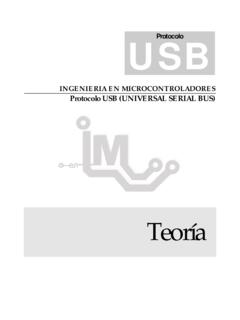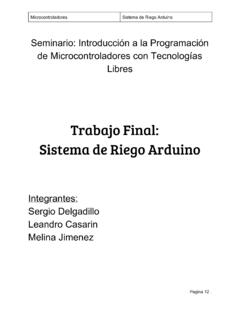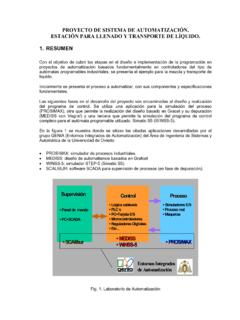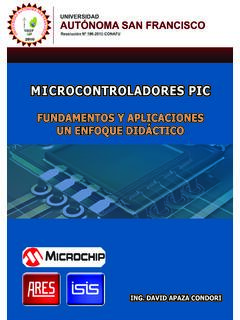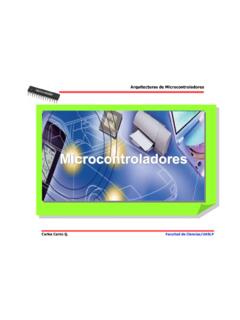Transcription of Floating point unit demonstration on STM32 …
1 May 2016 DocID022737 Rev 21/311AN4044 Application noteFloating point unit demonstration on STM32 microcontrollers IntroductionThis application note explains how to use Floating - point units (FPUs) available in STM32 Cortex -M4 and STM32 Cortex -M7 microcontrollers , and also provides a short overview of: Floating - point X-CUBE-FPUDEMO firmware is developed to promote double precision FPUs, and to demonstrate the improvements coming from the use of this hardware examples are given in Section 4: Application Rev 2 Contents1 Floating - point arithmetic .. or Floating - point .. unit (FPU) .. 72 IEEE standard for Floating - point arithmetic (IEEE 754) .. formats .. numbers .. numbers .. (Not-a-Number) .. modes.
2 Operations .. conversions .. and exception handling .. 123 STM32 Cortex -M Floating - point unit (FPU) .. operating modes .. status and control register (FPSCR) .. condition bits: N, Z, C, V .. bits: AHP, DN, FZ, RM .. flags .. management .. model .. instructions .. arithmetic instructions .. compare & convert instructions .. load/store instructions .. 174 Application example .. 18 DocID022737 Rev 23 set .. on STM32F4 .. on STM32F7 .. set .. 285 Reference documents .. 296 Revision history .. 30 List of tablesAN40444/31 DocID022737 Rev 2 List of tablesTable numbers dynamic .. 6 Table numbers dynamic.. 6 Table numbers range .. 9 Table numbers range.
3 10 Table range for number formats .. 10 Table implementation within the STM32 Cortex -M4/-M7 .. 13 Table register.. 14 Table Floating - point single-precision data processing instructions .. 16 Table Floating - point double-precision data processing instructions .. 16 Table -M4 performance comparison HW SP FPU vs. SW implementation FPU with MDK-ARM tool-chain .. 22 Table -M7 performance comparison HW SP FPU vs. SW implementation FPU with MDK-ARM tool-chain .. 23 Table comparison HW DP FPU versus SW implementation FPU with MDK-ARM tool-chain .. 24 Table documents.. 29 Table revision history .. 30 DocID022737 Rev 25/31AN4044 List of figures5 List of figuresFigure single and double precision Floating - point coding.
4 9 Figure set with value coded on 8 bpp blue (c= + ) .. 19 Figure set with value coded on an RGB565 palette (c= + ) .. 20 Figure FPU with MDK-ARM tool-chain .. 20 Figure of Mandelbrot-set with zoom in =1 .. 26 Figure of Mandelbrot-set using Double precision FPU with zoom in 48 times.. 27 Figure of Mandelbrot-set using Single precision FPU with zoom in 32 times .. 27 Floating - point arithmeticAN40446/31 DocID022737 Rev 21 Floating - point arithmeticFloating- point numbers are used to represent non-integer numbers. They are composed of three fields: the sign the exponent the mantissaSuch a representation allows a very wide range of number coding, making Floating - point numbers the best way to deal with real numbers.
5 Floating - point calculations can be accelerated using a Floating - point unit (FPU) integrated in the Fixed- point or Floating -pointOne alternative to Floating - point is fixed- point , where the exponent field is fixed. But if fixed- point is giving better calculation speed on FPU-less processors, the range of numbers and their dynamic is low. As a consequence, a developer using the fixed- point technique will have to check carefully any scaling/saturation issues in the algorithm. The C language offers the float and the double types for Floating - point operations. At a higher level, modelization tools, such as MATLAB or Scilab, are generating C code mainly using float or double. No Floating - point support means modifying the generated code to adapt it to fixed- point .
6 And all the fixed- point operations have to be hand-coded by the programmer. When used natively in code, Floating - point operations will decrease the development time of a project. It is the most efficient way to implement any mathematical 1. Integer numbers dynamicCodingDynamicInt848 dBInt1696 dBInt32192 dBInt64385 dBTable 2. Floating - point numbers dynamic CodingDynamicHalf precision180 dBSingle precision1529 dBDouble precision12318 dBDocID022737 Rev 27/31AN4044 Floating - point Floating - point unit (FPU) Floating - point calculations require a lot of resources, as for any operation between two numbers. For example, we need to: Align the two numbers (have them with the same exponent) Perform the operation Round out the result Code the resultOn an FPU-less processor, all these operations are done by software through the C compiler library and are not visible to the programmer; but the performances are very a processor having an FPU, all of the operations are entirely done by hardware in a single cycle, for most of the instructions.
7 The C compiler does not use its own Floating - point library but directly generates FPU native instructions. When implementing a mathematical algorithm on a microprocessor having an FPU, the programmer does not have to choose between performance and development time. The FPU brings reliability allowing to use directly any generated code through a high level tool, such as MATLAB or Scilab, with the highest level of standard for Floating - point arithmetic (IEEE 754)AN40448/31 DocID022737 Rev 22 IEEE standard for Floating - point arithmetic (IEEE 754)The usage of the Floating - point arithmetic has always been a need in computer science since the early ages. At the end of the 30 s, when Konrad Zuse developed his Z series in Germany, Floating -points were already in.
8 But the complexity of implementing a hardware support for the Floating - point arithmetic has discarded its usage for the mid 50 s, IBM, with its 704, introduced the FPU in mainframes; and in the 70 s, various platforms were supporting Floating - point operations but with their own coding techniques. The unification took place in 1985 when the IEEE published the standard 754 to define a common approach for Floating - point arithmetic OverviewThe various types of Floating - point implementations over the years led the IEEE to standardize the following elements: number formats arithmetic operations number conversions special values coding four rounding modes five exceptions and their Number formatsAll values are composed of three fields: Sign: s Biased exponent: sum of the exponent = e constant value = bias Fraction (or mantissa): fThe values can be coded on various lengths: 16-bit: half precision format 32-bit: single precision format 64-bit.
9 Double precision formatDocID022737 Rev 29/31AN4044 IEEE standard for Floating - point arithmetic (IEEE 754)30 Figure 1. single and double precision Floating - point codingFive different classes of numbers have been defined by the IEEE: Normalized numbers Denormalized numbers Zeros Infinites NaN (Not-a-Number)The different classes of numbers are identified by particular values of those Normalized numbersA normalized number is a standard Floating - point number. Its value is given by the above formula: The bias is a fixed value defined for each format (8-bit, 16-bit, 32-bit and 64-bit). Example: single-precision coding of -7 Sign bit = 1 7 = x 4 = (1 + 1/2 + 1/4) x 4 = (1 + 1/2 + 1/4) x 22 Exponent = 2 + bias = 2 + 127 = 129 = 0b10000001 Mantissa = 2-1 + 2-2 = 0b11000000000000000000000 Binary value = 0b 1 10000001 11000000000000000000000 Hexadecimal value = 0xC0E00000e( )sf( )se( )f( )8-bit311-bit023-bit6401-bit11-bit52-bit Single precision formatDouble precision formatTable 3.
10 Normalized numbers rangeModeExponentExp. BiasExp. RangeMantissaMin. valueMax. ValueHalf5-bit15-14, +1510-bit6, ,+12723-bit1,18. 10-383, ,+1023 52-bit2, , standard for Floating - point arithmetic (IEEE 754)AN404410/31 DocID022737 Rev Denormalized numbersA denormalized number is used to represent values which are too small to be normalized (when the exponent is equal to 0). Its value is given by the formula: ZerosA Zero value is signed to indicate the saturation (positive or negative). Both exponent and fraction are InfinitesAn Infinite value is signed to indicate + or - . Infinite values are resulting of an overflow or a division by 0. The exponent is set to its maximum value, whereas the mantissa is NaN (Not-a-Number)A NaN is used for an undefined result of an operation, for example 0/0 or the square root of a negative number.











